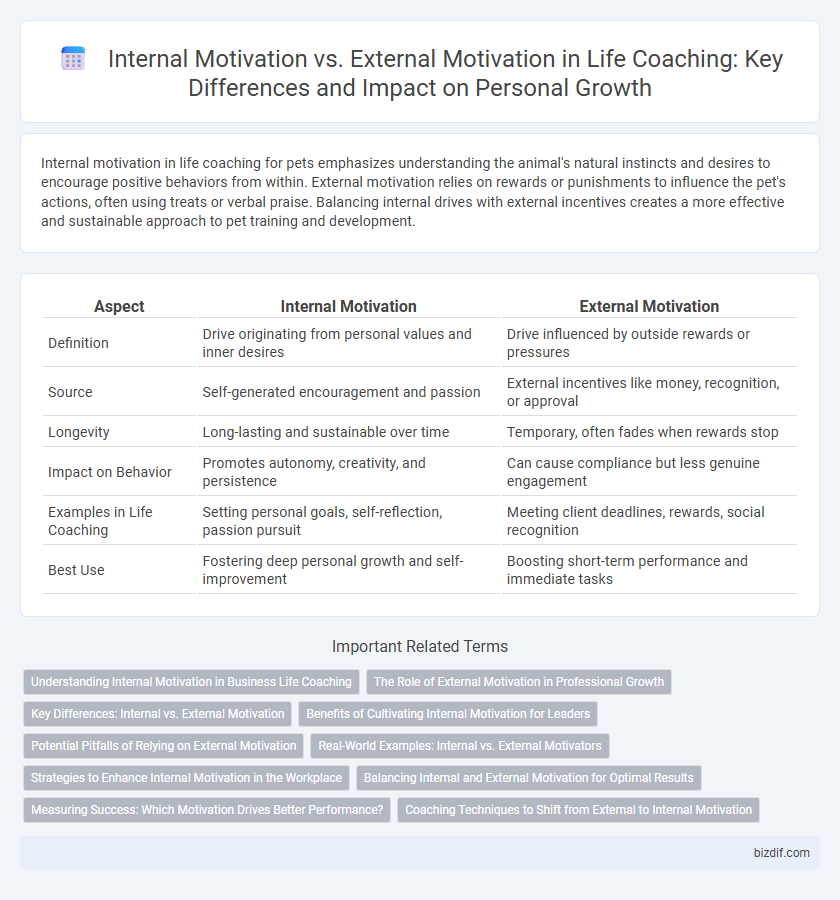Internal motivation in life coaching for pets emphasizes understanding the animal's natural instincts and desires to encourage positive behaviors from within. External motivation relies on rewards or punishments to influence the pet's actions, often using treats or verbal praise. Balancing internal drives with external incentives creates a more effective and sustainable approach to pet training and development.
Table of Comparison
| Aspect | Internal Motivation | External Motivation |
|---|---|---|
| Definition | Drive originating from personal values and inner desires | Drive influenced by outside rewards or pressures |
| Source | Self-generated encouragement and passion | External incentives like money, recognition, or approval |
| Longevity | Long-lasting and sustainable over time | Temporary, often fades when rewards stop |
| Impact on Behavior | Promotes autonomy, creativity, and persistence | Can cause compliance but less genuine engagement |
| Examples in Life Coaching | Setting personal goals, self-reflection, passion pursuit | Meeting client deadlines, rewards, social recognition |
| Best Use | Fostering deep personal growth and self-improvement | Boosting short-term performance and immediate tasks |
Understanding Internal Motivation in Business Life Coaching
Internal motivation in business life coaching drives sustained employee performance by fostering personal growth, autonomy, and aligned values. It emphasizes intrinsic factors like passion, purpose, and self-determination, which lead to higher engagement and creativity compared to external rewards or penalties. Understanding internal motivation enables coaches to develop customized strategies that enhance long-term commitment and resilience in professional settings.
The Role of External Motivation in Professional Growth
External motivation plays a crucial role in professional growth by providing clear goals, deadlines, and tangible rewards that drive individuals to improve performance and develop new skills. Performance bonuses, recognition from supervisors, and career advancement opportunities create an environment where employees feel motivated to exceed expectations and commit to continuous learning. While internal motivation fuels personal passion, external motivation often acts as a catalyst that accelerates skill acquisition and goal achievement in the workplace.
Key Differences: Internal vs. External Motivation
Internal motivation stems from personal values, intrinsic satisfaction, and a desire for self-improvement, driving sustained behavior and resilience. External motivation relies on rewards, recognition, or external pressures, often leading to short-term engagement but less enduring commitment. Understanding these key differences helps life coaches tailor strategies that foster authentic growth and long-term goal achievement.
Benefits of Cultivating Internal Motivation for Leaders
Cultivating internal motivation empowers leaders to sustain passion and resilience through intrinsic rewards such as personal growth, mastery, and purpose, leading to higher engagement and consistent performance. Leaders driven by internal motivation inspire authentic commitment and foster trust within their teams, enhancing collaboration and innovation. This self-driven focus reduces reliance on external validation, resulting in greater long-term leadership effectiveness and job satisfaction.
Potential Pitfalls of Relying on External Motivation
Relying heavily on external motivation, such as rewards or validation from others, can undermine long-term commitment and personal growth in life coaching. This overdependence may lead to decreased self-efficacy and vulnerability to discouragement when external incentives fade. Cultivating internal motivation fosters resilience and sustainable progress by aligning goals with intrinsic values and self-driven purpose.
Real-World Examples: Internal vs. External Motivators
Internal motivation drives individuals through personal satisfaction and intrinsic goals, such as a person pursuing a career change to find meaningful work. External motivation relies on outside rewards or pressures, exemplified by employees working extra hours to earn bonuses or avoid criticism. Life coaches often help clients recognize the deeper impact of internal motivators for long-term fulfillment versus the temporary boost from external incentives.
Strategies to Enhance Internal Motivation in the Workplace
Internal motivation, driven by personal values and intrinsic satisfaction, consistently leads to higher engagement and productivity in the workplace. Strategies to enhance this include setting meaningful goals aligned with employees' passions, offering opportunities for skill development, and fostering autonomy through trust and supportive leadership. Implementing regular feedback and recognizing achievements nurtures a sense of competence and purpose, further strengthening internal motivation.
Balancing Internal and External Motivation for Optimal Results
Balancing internal motivation, driven by personal values and intrinsic satisfaction, with external motivation, influenced by rewards and social recognition, enhances sustained success in life coaching. Coaching strategies that align goal-setting with clients' internal desires while incorporating external accountability mechanisms foster deeper engagement and resilience. Optimal results occur when clients harness both motivational sources to maintain consistent effort and adapt to changing challenges.
Measuring Success: Which Motivation Drives Better Performance?
Internal motivation, driven by personal goals and intrinsic satisfaction, consistently leads to higher performance levels as individuals engage deeply and persistently in tasks. External motivation, reliant on rewards or recognition, can boost performance temporarily but often lacks sustainability and diminishes when incentives are removed. Measuring success in life coaching reveals that cultivating internal motivation fosters long-term achievement and resilience, key indicators of effective personal growth and goal attainment.
Coaching Techniques to Shift from External to Internal Motivation
Coaching techniques that shift clients from external to internal motivation emphasize intrinsic goal-setting and self-reflection, enabling sustainable personal growth. Strategies include values clarification exercises, which align actions with core beliefs, and fostering autonomy through empowering decision-making processes. Utilizing positive reinforcement internally helps clients build self-efficacy, reducing dependency on external rewards or validation.
Internal motivation vs External motivation Infographic

 bizdif.com
bizdif.com